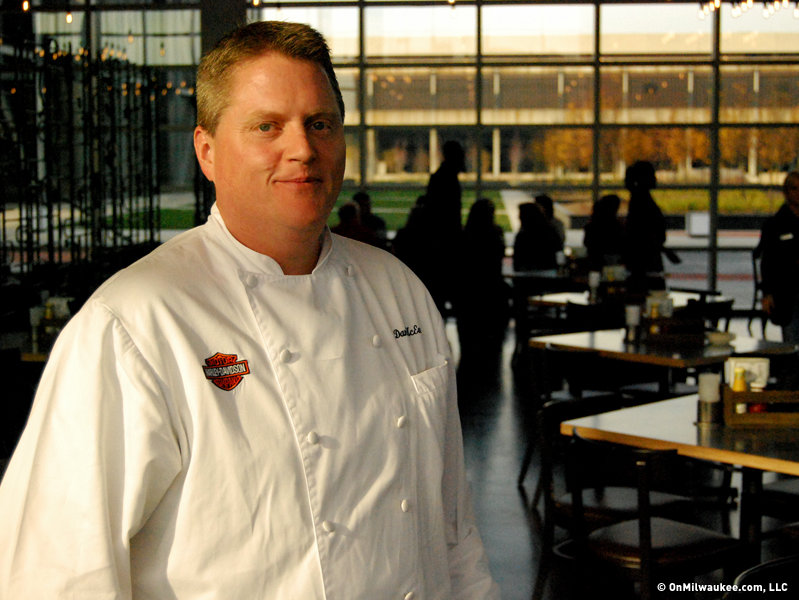When the iconic motorcycle whose leather-clad devotees will descend on us at full throttle Labor Day Weekend was introduced to the public 110 years ago, the name Harley Davidson was already famous around the world. It belonged to a man, not a machine, and like the hog that made Milwaukee famous, he was hell on wheels.
The original, oxygen-fueled Davidson was "without a doubt one of the greatest athletes that ever lived," marveled The Milwaukee Journal when the native of St. Paul, Minn., appeared here in early 1915. The newspaper article said the 44-year-old Davidson "has broke more records and entered more events in the different branches of sport than any other athlete in the world today" – including "running, swimming, track, boxing, baseball, bicycle racing, lacrosse, wrestling, (and) ice and roller skating."
It was as a roller skate racer that he was most celebrated. In the early 1900s, roller racing was hugely popular in Milwaukee and elsewhere, and Davidson was undisputed king of the track.
In the crowning achievement of his career, Davidson defeated 150 skaters in front of 14,000 fans at the Olympic Track in London for the world’s speed skating championship in 1909. He won the diamond medal and $2,000 in gold that went with it.
Davidson’s father, an acclaimed ice skater, strapped blades on his four children’s feet as soon as they could walk, and their childhoods were blurs as they raced to numerous titles and records. According to information from the National Museum of Roller Skating in Lincoln, Neb., Harley won the national ice-skating championship and "set several American records."
He was equally dominant when he exchanged his blades for wheels (four on each sole) and became a professional roller-skating racer in 1905. Two years later, when the Riverview Rink on the east shore of the Milwaukee River at North Avenue hosted the world championships, Davidson was the marquee attraction. He won the one-mile title against four challengers, circling the wooden oval 13 times in 3 minutes, 2.2 seconds.
Still champion in 1912, Davidson returned to Riverview that April to defend his title.
"That Harley Davidson, the present champion, will have to be at his best was shown yesterday when Roland Cioni, young Eastern skater, took his last workout on the course and covered the distance in 3:01," reported The Journal on the eve of the first race.
In the championship match, the younger Cioni held the lead after 11 laps, but then Davidson passed him and a lap after that he crossed the finish line a foot ahead of Cioni, tying his world record time of five years earlier.
The next day, Cioni won the two-mile championship race in a record 5:59. Davidson was in third place with four laps to go when, said The Journal, "the champion struck something on the floor which threw him against the posts and for a time it was thought that he was seriously injured."
Two nights later the bruised-up Harley stepped on the gas with two laps remaining and won the 10-mile championship race in 32:41:25 (another record), crossing the line six inches in front of the runner-up.
In the final event, the Riverview crowd of 3,500 was on its feet cheering for Davidson as he sprinted for the finish line in the five-mile championship race. But before he got there he took another spill, this one so hard he had to be carried off the track.
When the athlete whose name was emblematic of speed, thrills and daring before the locally-built motorcycle co-opted it returned to Milwaukee in 1915 for an exhibition at Riverview, he still held several ice and roller-skating speed records, and of the 3,630 races Davidson had entered in his career he’d won 3,035.
While Harley-Davidson vied for supremacy in the burgeoning motorcycle marketplace against Indian, The Flying Merkel, Pope and other brands, for speed-demons who preferred rolling under their own steam "Harley Davidson Roller Boots" were unrivaled top-of-the-line.
Davidson retired from competition in 1916, but continued traveling around showing his stuff in "fancy skating and dance exhibitions." As the Harley-Davidson motorcycle brand took off and the roller-skate racing’s popularity and his own fame diminished, H-D’s unhyphenated namesake sometimes claimed a connection with the Milwaukee company that didn’t exist. (His sister, Bertie Davidson, went in the opposite direction. Upon retirement from her own notable roller skating career she became an actress and called herself "Gilbertie Learcock.")
"Although extremely successful, roller racing and artistic exhibitions did not give Harley financial security," says a bio from the National Museum of Roller Skating. "Unlike the other professionals of that time, Davidson did not have a rink managing job to fall back upon. However, his former colleagues rallied to support the greatest professional roller racer of all time, and in the 1940s were able to raise funds for him through several testimonial dinners."
Some accounts say that Davidson was also a successful motorcycle racer at one time, but the internal-combustion engine ultimately was his downfall personally and well as professionally. He died in 1946 after a long invalidism caused by injuries suffered in an automobile accident.





